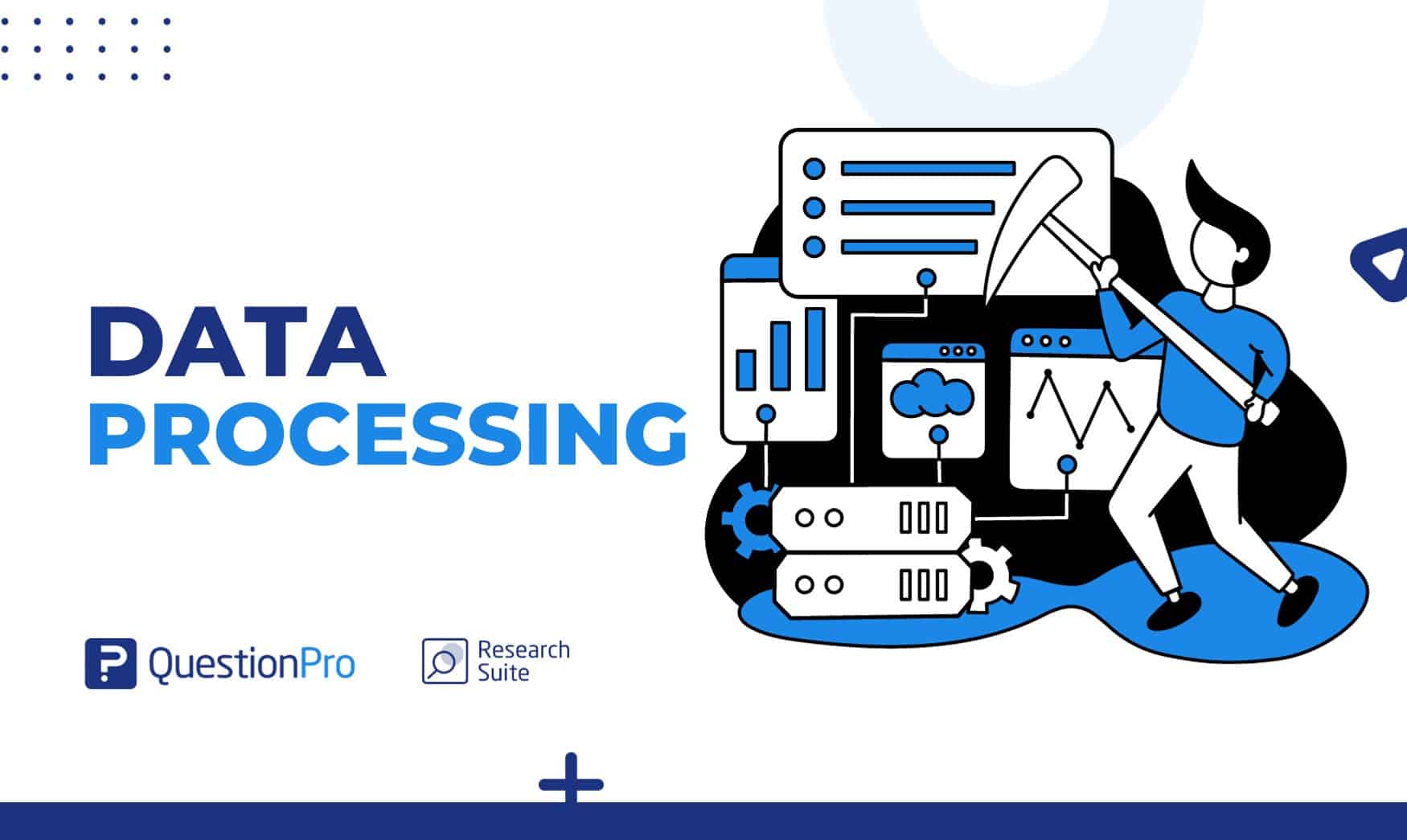
We are constantly surrounded by data. Whether it’s the photos on your smartphones, the emails in your inboxes, or the results of a customer satisfaction survey, data is all around us. But what happens to all this data? How do you make sense of it? The answer lies in the world of data processing.
In this blog, we’ll explore the fundamentals of processing, including what it is, its types, stages, and methods to follow. Stay with us to explore in detail!
What is data processing?
Data processing happens when information is collected and transformed into something useful. It is often done by a data scientist or a team of them. It’s crucial to get it right so that the final result, or data output, isn’t messed up.
First, you collect data from different places. Then, you arrange it so computers can understand. After that, special computer tools analyze and work with the data, pulling out important details. The end result, like charts or reports, is what we get in the output phase.
Think of it like cooking a recipe; you gather ingredients, prepare them, cook, and finally, you have a tasty dish. The processed data, the final product, can also be saved for later, like keeping leftovers for another meal. Basically, it helps us take raw information and turn it into something we can use to make smart decisions in many different areas.
Importance of Data Processing
The data processing cycle is crucial for several reasons, playing an important role in our increasingly digital and information-driven world. Here are some key reasons why processing is important:
Making Data Understandable
Raw data is often like an unreadable book. Data processing transforms this raw information into a readable and understandable format. It organizes, structures, and arranges data so that humans and computers alike can understand and interpret it.
Informed Decision-Making
In every aspect of life, decisions are made based on information. Processing extracts valuable insights from raw data, providing a foundation for informed decision-making. Whether in business, healthcare, education, or daily life, processed data guides choices that can lead to better outcomes.
Identifying Patterns and Trends
Data processing helps reveal hidden patterns and trends within the information. Whether it’s understanding consumer behavior, predicting weather patterns, or identifying market trends, processed data allows us to recognize and leverage patterns that may not be apparent in raw data.
Enhancing Efficiency
Just as a well-organized workspace improves efficiency, processing streamlines information. It makes data accessible and ready for use. It reduces the time and effort required to find relevant information. This efficiency is critical for businesses and organizations looking to optimize their operations.
Visual Representation
Humans are visual creatures, and processing enables the creation of visual representations such as graphs, charts, and reports. These visual aids make complex information more digestible, allowing individuals to grasp insights quickly and make sense of data at a glance.
Predictive Analysis
Data processing is not just about the past; it also helps predict future trends. Analyzing historical data, patterns, and behaviors enables predictive analysis. This capability is particularly valuable in fields like finance or healthcare, where anticipating disease outbreaks can be critical.
Automation and Artificial Intelligence
With the rise of automation and artificial intelligence, processing has become the backbone of these technologies. Automatic data processing enables machines to learn from data, make decisions, and perform tasks without explicit programming. This, in turn, leads to increased efficiency and innovation across various industries.
Improving Accuracy
Raw data may contain errors or inconsistencies. The data processing system includes validation and cleansing steps that improve the accuracy of the data. This is essential for making reliable decisions based on trustworthy information.
Types of data processing
Let’s break down some types of data processing in a way that’s easy to understand:
01. Batch Processing
Data is collected, processed, and handled in groups or batches in batch processing. This method is efficient for dealing with large volumes of data at scheduled intervals, where immediate results are not a primary concern.
02. Distributed Processing
Distributed processing involves spreading out data processing tasks across multiple computers or servers. This approach is beneficial when dealing with large datasets that may not fit on a single machine.
03. Real-time Processing
Real-time processing ensures that data is processed as it’s generated without any delay. This method requires high-speed processing systems. It is essential for applications requiring quick decision-making or immediate responses to changing data.
04. Parallel Processing
Parallel processing is like having a team of processors working together. It breaks down a complex task into smaller sub-tasks that can be processed simultaneously. It also reduces overall processing times and improves efficiency.
05. Online Transaction Processing (OLTP)
OLTP focuses on managing and processing a large number of small transactions in real-time. It is commonly used in applications where quick and immediate transaction processing is crucial.
Stages of data processing
In this section, we’ll simplify the journey through the stages of data processing, making it easy to grasp and apply:
Stage 01: Data collection
The first stage in processing is to gather information, a crucial part of the data input or data collection process. We get this data from various places, like data lakes and warehouses. It’s really important that the sources we pick are reliable and well-made. This ensures that the data we collect, which we’ll use as information later, is of the best quality possible.
Stage 02: Data Preparation
Preparing the data means making it clean and organized to be sure it’s accurate, consistent, and easy to use. Identify any duplicate entries, missing or incomplete data, and take the necessary steps to fix them. This step boosts the integrity of your data before processing, leading to more accurate results.
Stage 03: Processing
In this stage, you’re doing various operations on the data to find useful insights. This can be done manually or with automated tools. Here, you use different techniques like adding up, filtering, sorting, and analyzing to turn raw data into meaningful and useful information.
Stage 04: Storage
Once the processing is done, you save the data for later use. This way, you or others can easily access the information and make the most of the processed data. Storing the data in databases or data warehouses ensures that it’s readily available when needed in the future.
Stage 05: Retrieval
After you’ve stored the data, you can bring it back whenever you need it. Retrieving data means using techniques like queries or searches to access the stored information. You might retrieve data to do additional processing and analysis.
Stage 06: Presentation
The last stage of processing data is displaying it in a meaningful way. Techniques like using charts, graphs, dashboards, or reports are employed to help users grasp and interpret the information. It’s crucial to present data effectively to convey insights clearly and accurately.
Methods to Follow in Data Processing
When selecting a processing type, there are three methods you can consider, but keep in mind that not all the data processing methods are suitable for every processing type:
01. Manual Processing
Manual processing happens when people handle the data without using machines or electronics. While not as common nowadays, it still has its uses. For instance, during a vote recount, a government agency might choose to manually count the ballots.
02. Mechanical Processing
Mechanical processing involves using simple devices in your data work. Tools like calculators or typewriters can assist in processing and converting information into a usable format. This method can speed up projects and reduce the chance of errors.
03. Electronic Processing
Electronic processing is the most popular method in modern times, where you use computer devices. It’s the go-to choice for many business experts because it can increase capability and speed. Automating data processing with computers also helps minimize errors in the process.
Utilizing QuestionPro in data processing
QuestionPro is a survey and research platform that provides tools for creating and distributing surveys, collecting responses, and analyzing data.
While it may not be specifically designed for data processing in the traditional sense, it does offer features that can aid in the overall data processing workflow. Here are some ways in which QuestionPro can assist in it:
- Data Collection: The platform collects and stores survey responses in a structured manner, making it easy to access and manage the data.
- Data Validation and Quality Control: QuestionPro may include features for data validation. It ensures that responses meet certain criteria or are within specified ranges. This helps maintain data quality.
- Real-time Reporting: The platform may provide real-time reporting tools, allowing users to view and analyze data as it comes in. This can be beneficial for quick decision-making.
- Data Export: Users can export survey data in various formats, such as Excel or CSV, for further processing in external tools or software.
- Integration with External Tools: QuestionPro offers integrations with other data analysis tools like Excel, SPSS, or other statistical software. This facilitates more in-depth processing and analysis.
- Automated Reporting: QuestionPro has features for automated data processing report generation, which can save time in summarizing and presenting survey results.
Conclusion
Data processing is like giving superpowers to information. Whether you’re a business analyst, scientist, or student, knowing how to handle data can make you a real winner. It’s all about understanding the different ways to deal with information, the steps involved, and the methods to make it work like magic.
So, it’s not just about processing data. It’s about turning boring facts into exciting insights. The real trick is to get valuable knowledge that helps you make smart decisions. If you have specific questions or need assistance, you can also reach out to QuestionPro’s support team.







